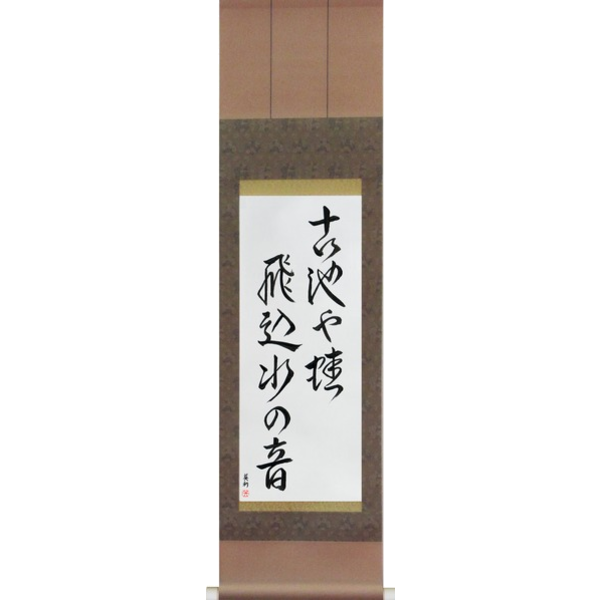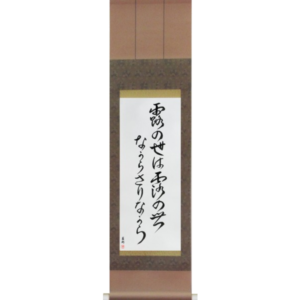H3009 – Haiku by Basho – The old pond …
by Master Japanese Calligrapher Eri Takase
The old pond,
a frog jumps in,
the sound of water [1]
|
furu ike ya kawazu tobikomu mizu no oto |
古池や 蛙飛込 水の音 |
| bashou | 芭蕉 |
Asataro Miyamori suggests the translations:
The ancient pond!
A frog plunged – splash!
The old pond! A frog plunged –
The sound of the water! [2]
Harold Henderson suggests the translations:
Old pond –
and a frog-jump-in
water-sound [3]
As we quote Henderson in Basho – Taken ill on my travels, My dreams roam over the withered moors:
During his last illness he was constantly discussing religion and philosophy and poetry (three things that were almost one to Basho), and when it became evident that he was dying his friends asked him to give them a “death poem” – the sum of his philosophy. Basho refused, on the ground that every poem in his last ten years, starting with the “old pond” haiku, had been composed as if it were a death poem.
Indeed, Basho himself points at this poem as being the turning point in his philosophy towards haiku.
Daniel C. Buchanan suggests the translations:
Into the old pond
A frog suddenly plunges.
The sound of water. [4]
Jane Reichhold suggests the translations:
old pond
a frog jumps into
the sound of water [5]
Reichhold writes:
1681-82 – spring. This verse, now so famous, was first published in a selection of single verses Haru no Hi (Spring Day). What made this verse interesting was the fact that poetry up until this time had mentioned frogs for their croaking but never for their leaping. According to the commentary by Shiko, at first Basho thought of the 7-5 sound units “a frog jumps into / the sound of water (kawazu tobikomu / mizu no oto).” Then he tried to think of a good five sound units for the first line. Kikaku proposed “Yamabuki ya (Japanese yellow rose)”. Basho said that yamabuki would be elegant but too showy. He said “furu ike ya” should be used because it is simple and truthful. [6]
Robin D. Gill, in his article Can One Hundred Frogs All Be Wrong?, explores the question of whether this most famous haiku can be perfectly translated into English in the first place. This is an excellent article for understanding the intricacies of Basho’s haiku and the issues faced by the translator. This article, like all of Mr. Gill’s work, is fascinating.
Calligraphy Notes:
1) Note that we have used the shorted version of tobikomu, the full form is 飛び込む (read tobikomu) meaning “to jump in; to leap in; to plunge into; to dive in”.
References:
[1] Translation by R. H. Blyth.
[2] 84-87.
[3] 20.
[4] 88.
[5] 59.
[6] 262.





